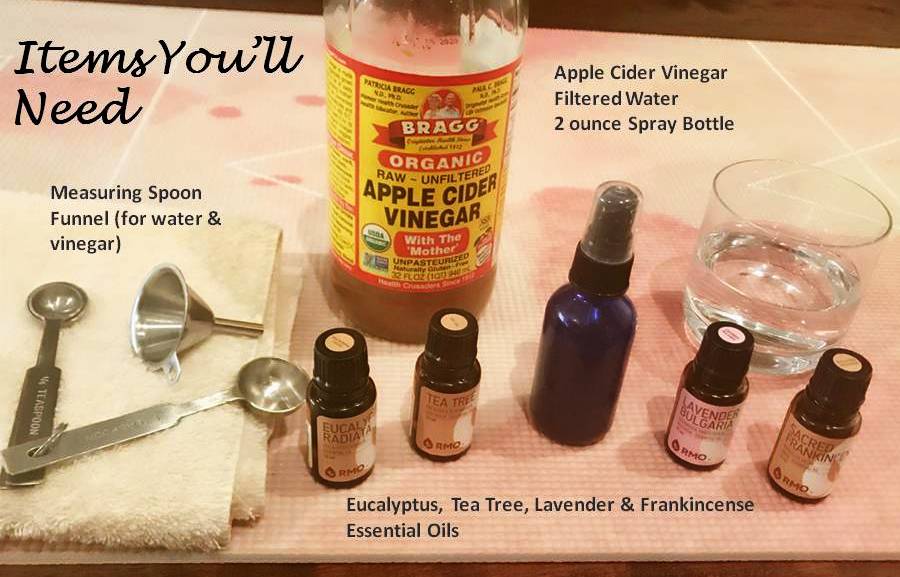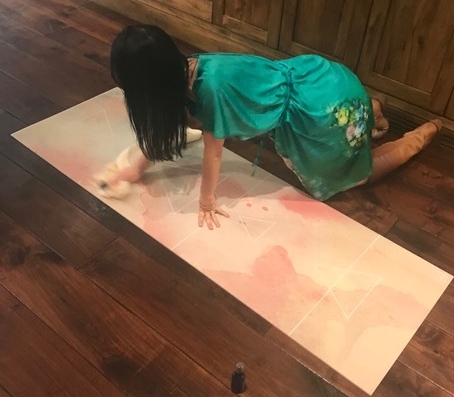I love yoga for its many physical and mental benefits, and our mats can get quite sweaty and dirty after practice.
YogiApproved.com writes “When you roll the mat onto the floor, and roll it up again later, you’re rolling whatever mystery goodies (or not-so-goodies) up with it – rolled onto the side that you put your hands and feet and face on too.” Additionally, they note “In a lab test conducted on several different yoga mats, some of the mats were found to have Staph, yeast build-up (a form of fungus), fecal matter, allergens, and millions of bacteria, to name just a few of the findings.” Seriously gross, right?
Cleaning our yoga mats is essential to preventing bacterial growth and maintaining our mat's integrity for as long as possible. But, the problem with most yoga mat cleaners is that they may contain harsh or toxic ingredients (even the “all natural” sprays & wipes may contain questionable emulsifiers, chelating agents, surfactants, and preservatives), they can be expensive, and waste resources if they come in a non-reusable plastic container (among additional wasteful packaging).
I recently purchased a new mat, and it was important to me to make a nontoxic yoga mat cleaner myself, so I wanted to share an easy DIY recipe with tips on making your own cleaner.
I say skip those overpriced and potentially chemical-filled store-bought yoga mat cleaners and make your own natural cleaner in 10 minutes with these easy DIY recipes below - all with items you can reuse.
DIY Cleaning Spray Recipe for Standard Yoga Mats
Below is the recipe I used along with the reasoning and benefit of the essential oils included. It cleans and smells pleasant.
Yoga Mat Cleaning Spray Ingredients
1 Tablespoon Apple Cider Vinegar (ACV) (1 part vinegar)
3 Tablespoons Filtered Water (3 parts water)
6 drops Eucalyptus Oil (or Radiata)
5 drops Tea Tree Oil (Melaleuca)
10 drops Lavender Oil
10 drops Frankincense Oil (or Frankincense Serrata)
Directions
Start by adding 1 Tbsp of Apple Cider Vinegar to your 2 oz glass spray bottle.
Next, add approximately 3 Tbsp of Filtered Water to your 2 oz spray bottle leaving enough room at the top to add essential oils without spillage.
Add in all of the essential oils to your spray bottle (order does not matter, but obviously drip in one at a time).
Close the bottle, shake well, and let synergize.
*If using a larger spray bottle you need only adjust to ¼ of the bottle filled with ACV and ¾ of the bottle filled with filtered water, and increase your essential oils accordingly. My recipe is a little under 2% dilution, which is the maximum I recommend to be safe, and you can see dilution rates here.
“This is perfect. It’s earthy, smells good & the vinegar smell is no longer the overpowering scent. After my mat was dry I could smell the essential oils faintly but no vinegar. I love it.”
I started with fewer Essential Oils added to the mixture, but the vinegar smell was so strong I increased my oils to 5 drops under 2% dilution. With this many oils, the smell was much more pleasant than just overpowering vinegar and I could pick up the aromatherapy of the EOs.
I chose Bragg’s Apple Cider Vinegar because it is organic, raw (less processing = better for the environment and you), and can be used for dressings, beverages, and so on as it has many health benefits. It acts as an emulsifier to break up any oils on the surface of your mat and has antibacterial and anti-fungal properties. This vinegar is great for deodorizing and disinfecting your mat naturally.
You can substitute a more processed white vinegar or alcohol-free witch hazel for the ACV. For witch hazel, I recommend Thayer’s as theirs is cruelty-free, paraben free, phthalate-free, gluten-free, un-distilled and made in the USA.
Why These Essential Oils?
Not only do the essential oils in this recipe add a lovely aroma to your cleaner (vinegar can be off-putting and strong by itself), they also fight germs and odor on your mat.
Tea Tree oil (also known as Melaleuca) is antibacterial, anti-fungal, and anti-viral. It may be the most well-known antiseptic, and although I personally don’t love its scent, this is a powerful essential oil for disinfecting your mat naturally.
Eucalyptus oil also has antibacterial, antifungal, anti-microbial, and antiseptic properties and is excellent for removing odors. I prefer its “fresh, clean, and slightly woody aroma” to Tea Tree’s aroma. Eucalyptus essential oil is considered purifying, invigorating, soothing, and cooling. It has numerous health benefits and uses outside of a cleaning agent.
Both Tea Tree and Eucalyptus blend well with Lavender oil, one of the most famous essential oils known for its calming and uplifting abilities. However, Lavender is also antibacterial and anti-viral. Not only is it a great scent to use for relaxation, tension relief, mood enhancement as well as for skincare, it can also fight germs.
Frankincense is considered a “healing” oil. It is known as being incredible for prayer and meditation, which is perfect for yoga, as it has sedative properties that fight stress and anxiety. I added it for its aromatherapy benefit, though it also has antiseptic and disinfectant properties to add benefit to cleaners.
All of these oils also have numerous health benefits and uses not mentioned here.
Additionally, this mix is well balanced as it pertains to scent and the 3 different notes by which EO aromas are classified:
Top Note - light and fresh smelling, usually first scent noticed in a blend and most volatile: Eucalyptus (others include Grapefruit, Lemon, Peppermint, Mandarin, etc.)
Middle Note - the main body of the perfume, lasting fragrance noticed after top note: Lavender and Tea Tree (others include Geranium, Rosemary, Thyme, etc.)
Base Note - heavier and richer than other notes, and maybe the last scent to pick up, but it is supposed to linger the longest and help maintain the blend’s aroma longer: Frankincense (others include Sandalwood, Neroli, Rose, etc.)
Make It Your Own
You can of course adjust the essential oils added to your DIY yoga mat cleaning spray to your liking. You can adjust the ratios of the oils I used, or use only Eucalyptus or Tea Tree for instance. You could also sub other popular oils for cleaners such as:
Lemon or Peppermint instead of Tea Tree or Eucalyptus, which are both antibacterial and energizing.
Geranium instead of Lavender, which is another middle note oil with antiseptic properties.
Cinnamon is a great warming oil for winter that has antiviral and anti-parasitic properties.
Thyme is an antiseptic, antibacterial top-middle note oil with calming properties, and many enjoy its herbaceous aroma.
I encourage you to play around with the essential oils to tailor to your scent preferences as long as you have germ-fighting oils included. Have fun making the best yoga mat cleaner for you.
DIY Cleaning Spray Recipe for Jade Yoga Mats (Natural Rubber Mats)
I recently purchased a Jade Yoga Mat during my search for the right Eco mat for me (post on that search coming soon!). I love it and want to care for it properly, and found that the way you clean a natural rubber yoga mat differs from how to clean a typical yoga mat. How to safely clean a natural rubber yoga mat involves (although sadly) no high concentration essential oils.
Jade advises to only use vinegar and water to cleanse your mat (or a mild soap if all soap residue is removed). They note on their website, "The really important thing is to NEVER use alcohol, petroleum based solvents or high concentration essential oils on your mat. Unfortunately these cleaning products adversely impact the natural rubber in our mats, causing it to break down and dry out."
(Jade) Natural Rubber Yoga Mat Cleaning Spray Recipe
1 Tbsp Apple Cider Vinegar
3 Tbsp Water (purified / distilled best)
*If you want your cleanser to be more potent, you can increase the mix to 50/50 of water and vinegar to naturally disinfect while maintaining the rubber mat’s texture and color. This 50/50 mixture is recommended for use on other biodegradable mats that aren’t rubber, such as Manduka eco mats.
Directions
Simply add the apple cider vinegar and filtered water to a 2 oz glass spray bottle, close and shake well to mix thoroughly. Your cleaner is now ready for use using the instructions below.
*For me personally, I think a small amount of EOs added to my Jade mat cleaner once in awhile will be OK, such as a drop of Eucalyptus, Lemon or Lavender, but caution is recommended.
How to Use the DIY Yoga Mat Cleaning Spray
Once you have your cleaner made and ready, it is very easy to use on your mat. Simply follow these instructions:
Shake the cleaning spray bottle well before use and then spray the yoga mat cleaner over the entire surface of your mat (safe to use liberally).
If you think your mat is quite dirty and want a deeper clean let the solution settle on the mat for 5 minutes.
Take a damp towel, and wipe your whole mat down, removing all of the cleaner residue. (I tend to wet my towel multiple times to remove the cleaner thoroughly).
Allow your mat to air dry. (This should only take 5-10 minutes, but you can also wipe the remaining moisture with a dry towel or washcloth. Do NOT use the sun to air dry your mat as for many mats this will speed up it degrading and compromise its integrity allowing warping or discoloration.)
Repeat on the other side.
*You can use the essential oils spray to clean/sanitize other exercise equipment as well.
**If you need a deep clean once in awhile you can opt to soak your mat in a bathtub for an hour with ~1 cup vinegar or mild Dr. Bronner’s all purpose soap and essential oils (except with Jade/rubber mats - no EOs in bath), then rinse and hang on your shower curtain rod to air dry, which may take up to 48 hrs.
Conclusion: You Can Keep your Yoga Mat Clean & Deodorized in a Easy, Green, DIY Way
You can feel good knowing you made your own yoga mat cleaner at home in a reusable spray bottle with all natural ingredients.
These easy, natural cleaning sprays are perfect for cleaning your yoga mat on a regular basis - either after each use, or at least weekly (the most common recommendation).
When you DIY your cleaners you can ensure they are, like the yoga mat cleaners in this post:
Antibacterial & Antiviral
100% Biodegradable
Chemical FREE
Bleach FREE
Phosphates FREE
Alcohol FREE (won’t dry out your mat)
Cruelty Free
Environmentally friendly (you can reuse every ingredient and make repeatedly with same bottle!)
I hope you enjoy your nontoxic homemade yoga wash and enjoy having a fresh and clean yoga mat that may also smell great for your practice.
DISCLAIMER: The content on this blog is for educational and informational purposes only, and is not intended as medical advice. I am not a medical doctor, nor am I providing any medical advice. These statements have not been evaluated by the Food and Drug Administration. Rocky Mountain Essential Oils and any other products mentioned in this post are not intended to diagnose, treat, cure, or prevent disease.
As a Rocky Mountain Oils & Amazon affiliate we will receive a very small commission on purchases through the links included in this post, but the price you pay remains unchanged. Thank you for supporting us.





